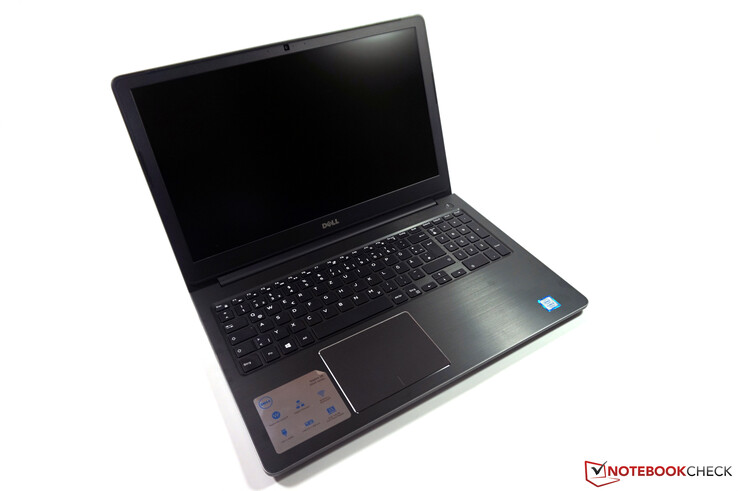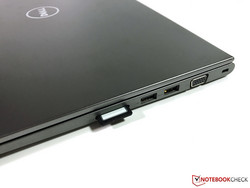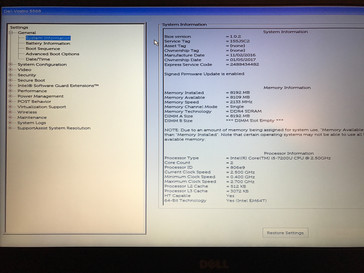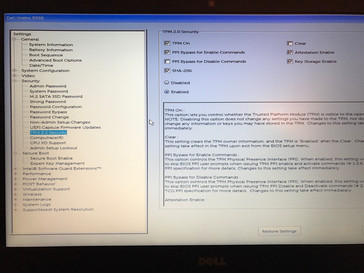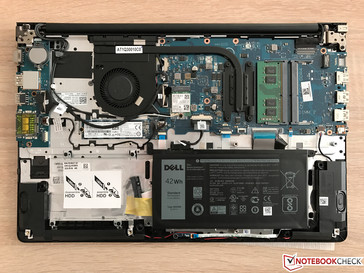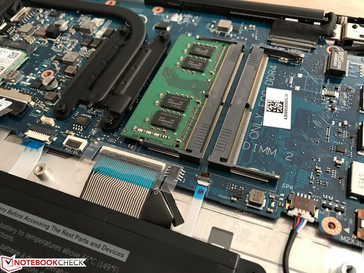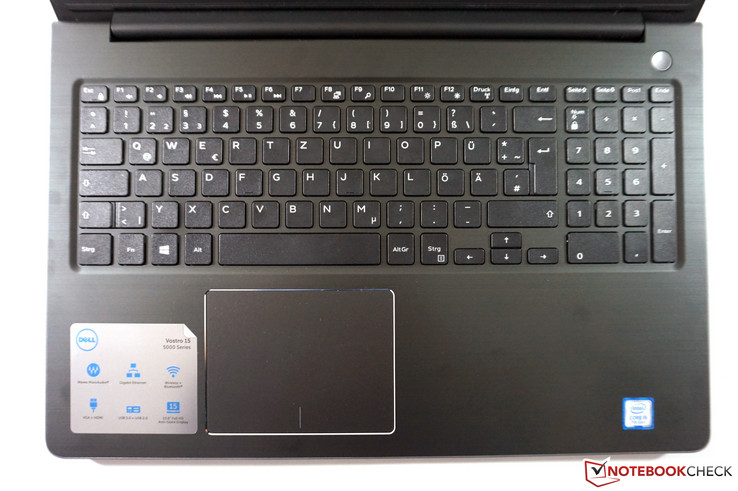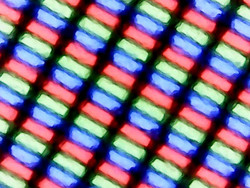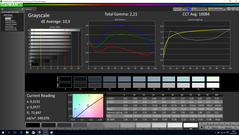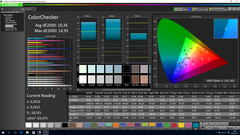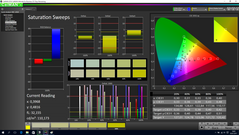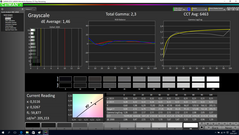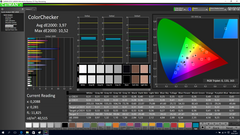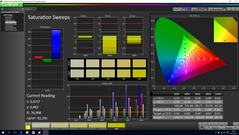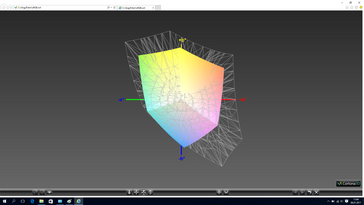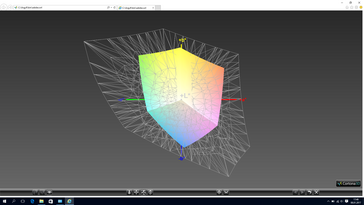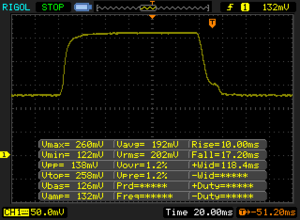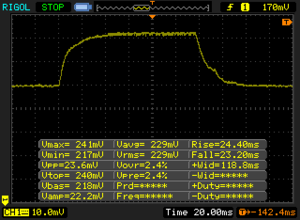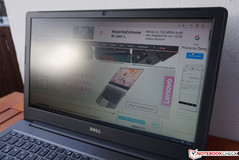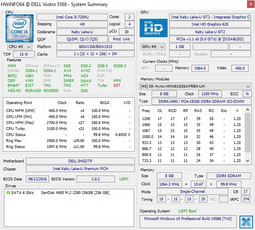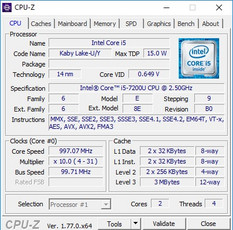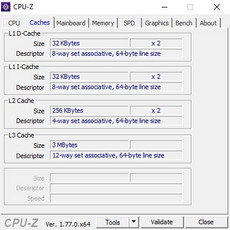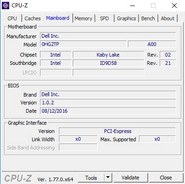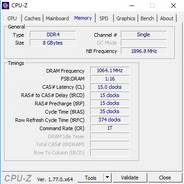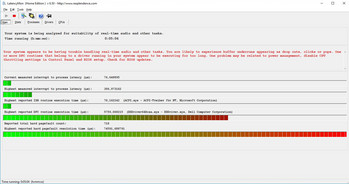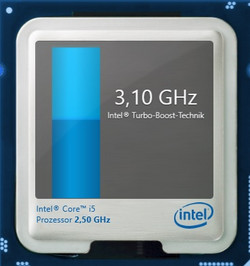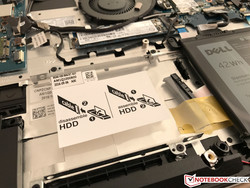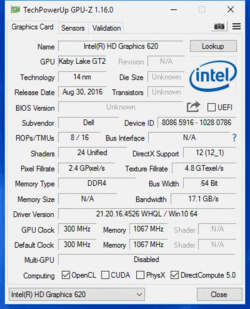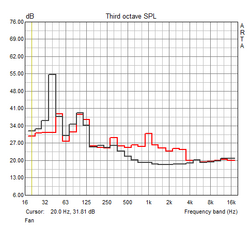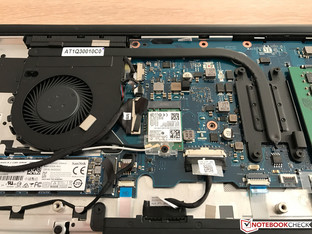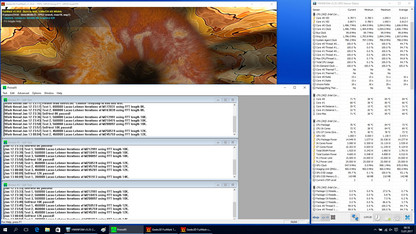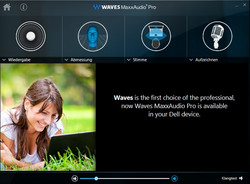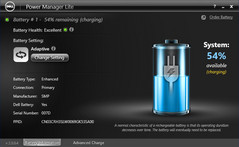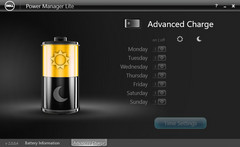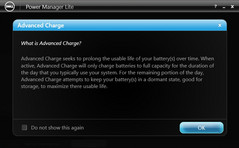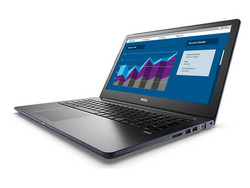Dell Vostro 15 5568 (Core i5-7200U, Full-HD, 2017) Notebook Review

For the original German review, see here.
Dell's Vostro lineup is designed for business customers. The inexpensive 15-inch systems cover all the essentials and focus on the productivity. The manufacturer has two different series: The 3000-series models start at 239 Euros (~$255, excl. VAT) and use simple cases with optical drives. Models from the 5000-series are equipped with a nicer chassis and have more similarities with Ultrabooks (no optical drive).
Our test model is a Vostro 15 5568 with a Core i5 processor, 8 GB DDR4-RAM, 256 GB SSD as well as a matte FHD TN panel. This preconfigured model is listed for 619 Euros (~$660, excl. VAT) in Dell's online shop. Rivals for the Vostro 15 are other business devices like the HP ProBook 450 G4, the Acer TravelMate P259, and the Lenovo ThinkPad E570, which is currently in review as well.
Case
We were positively impressed when we saw the Dell Vostro 15 for the first time, because the design does not have to hide behind devices that are more expensive. The dark gray chassis reminds us a lot of modern Ultrabooks, and the notebook looks thinner than it actually is because of the slightly wedge-shaped bottom panel. The elegant impression continues once you open the lid. The top of the base unit has a subtle pattern, and both the black keyboard and the polished edge around the touchpad create a nice contrast.
Dell uses a plastic chassis, although this is not a big surprise considering the price. We still like the stability of the base unit in particular, which is also supported by the two large support feet at the bottom. There are no creaking sounds, only the central keyboard area can be pushed in with some force, but this is no problem in practice.
The only weak spot is the thin lid, which is fairly torsion-resistant, but pressure from behind will quickly result in ripples on the screen. The central display hinge is very taut, and you need both hands to open the lid, but bouncing is prevented effectively in return. The maximum opening angle is sufficient at 135 degrees.
The battery cannot be accessed from the outside and there are no maintenance hatches, either. You can only gain access to the components when you remove the whole bottom panel, but more on that later.
Connectivity
The Dell Vostro 15 offers the essential ports, but there are no highlights. There are four standard USB ports, and three of them support the fast 3.0 standard. That there is one USB 2.0 port is no problem in our opinion, because both sides have a fast connector. A modern USB Type-C port, however, is not available. The transfer rates of the USB ports are just mediocre at around 200 MB/s; our external Samsung SSD T3 would support higher speeds (>400 MB/s).
Video output is either possible via HDMI (4K @30 Hz) or the slightly outdated VGA port. There is also an SD-card reader as well as a fold-out Gigabit Ethernet jack. Dell does not offer a SmartCard reader or a docking port, so you will have to use USB docking stations.
SD Card Reader
The internal SD-card reader is only attached via USB 2.0, because we can only determine low transfer rates in combination with our reference card from Toshiba (Exceria Pro 64 GB UHS-II, up to 260 MB/s). The maximum sequential transfer rate is just 25 MB/s according to AS SSD, and a folder with JPEG files (~5 MB each) is transferred at 25 MB/s as well. A permanent storage expansion is not only prevented by the low performance, but the memory card also sticks out from the chassis.
| SD Card Reader | |
| average JPG Copy Test (av. of 3 runs) | |
| HP ProBook 450 G4 Y8B60EA | |
| Acer TravelMate P259-MG-71UU | |
| Lenovo ThinkPad E570-20H6S00000 | |
| Dell Vostro 15-5568 | |
| maximum AS SSD Seq Read Test (1GB) | |
| HP ProBook 450 G4 Y8B60EA | |
| Lenovo ThinkPad E570-20H6S00000 | |
| Dell Vostro 15-5568 | |
Communication
Our test model is equipped with the WLAN module Dual-Band Wireless-AC 3165. It is a 1x1 adapter with a maximum transfer rate of 433 Mbps. This means it is not one of the fastest modules out there, but modern technologies like 5 GHz networks, the 802.11ac standard as well as Bluetooth 4.2 are supported.
The results in our standardized WLAN test with the router Linksys EA8500 are decent considering the 1x1 adapter. We determine 205 Mbps send and 268 Mbps receive, so the Vostro 15 obviously falls behind 2x2 adapters. If you want higher transfer rates, you can get the optional Dual-Band Wireless-AC 8260 module. WWAN modules are not available for the Vostro 15.
The usual HD webcam as well as two microphones are located above the display. The quality is okay for video conferences, but you should use the smartphone for snapshots.
| Networking | |
| iperf3 transmit AX12 | |
| Acer TravelMate P259-MG-71UU | |
| Lenovo ThinkPad E570-20H6S00000 | |
| Dell Vostro 15-5568 | |
| iperf3 receive AX12 | |
| Acer TravelMate P259-MG-71UU | |
| Lenovo ThinkPad E570-20H6S00000 | |
| Dell Vostro 15-5568 | |
Security
The Vostro 15 only meets the minimum security requirements. Our test model is only equipped with a slot for a Kensington Lock as well as a Trusted Platform Module 2.0 (TPM). There is at least an optional fingerprint scanner, but you cannot get a SmartCard reader. Unlocking the system via Windows Hello is not supported, either.
As per usual for business laptops, the Vostro 15 comes with a very comprehensive BIOS. The user interface looks a bit outdated, but the handling via touchpad is very simple and also comfortable in return. Besides different passwords and settings for the TPM 2.0, you can also configure or deactivate nearly every individual component or port.
Accessories
The Vostro 15 5568 is only shipped with a 45-watt power adapter (65 watts for dedicated GPU) as well as some service leaflets. Dell does not offer any special accessories for the Vostro, but customers can choose from an armada of generic accessories including USB docking stations, external batteries, bags, or input devices.
Maintenance
The Vostro 15 is not very easy to maintain. There is no maintenance hatch at the bottom, and you will have to remove the whole bottom part of the base unit to access the components. After 11 screws are removed, you have to pry open the chassis. We recommend a corresponding tool, but it is still quite fiddly. One positive aspect is that Dell does not use fragile plastic clips.
Once the bottom is removed, you gain access to all important components. This includes the two RAM slots (one free), the M.2-SSD (2280), the WLAN module, the battery, and the CMOS battery. The fan is also accessible for cleaning. Next to the battery is a free slot for 2.5-inch drives as well as the necessary connectors – exemplary.
Warranty
Dell grants a one-year warranty for the Vostro, which includes a Collect & Return service. Both the service scope and the warranty period can be expanded for a comparatively small amount of money – an upgrade to a three-year On-Site service, for example, costs about 40 Euros (~$43).
Please see our Guarantees, Return Policies & Warranties FAQ for country-specific information.
Input Devices
Keyboard
One weak spot of the Dell Vostro 15 are the input devices. The black chiclet keyboard has a dedicated numeric keypad, but the key travel and the typing experience remind us of an inexpensive slim Ultrabook. There is some clattering and the key travel is very shallow, which affects the comfort. The pressure point is still pretty well defined and the input is certainly sufficient for everyday tasks, but frequent writers should look out for another device.
A keyboard illumination is optional, but our test model was unfortunately not equipped with it.
Touchpad
The Vostro 15 does not offer a TrackPoint, so you can only use the ClickPad for cursor movements. It is conveniently sized at 10.5 x 8 cm (~4.1 x 3.1 in) and sits in a slight depression in the palm rests, so you can easily feel the transition. The polished surrounding edge is a visual highlight.
However, the handling of the ClickPad with the slightly roughened surface is not convincing. We can hear a slight clatter when we tap it, which does affect the quality impression a bit. Cursor movement is no problem, but we often struggled with stutters during drag & drop actions. The integrated buttons leave a decent impression and they are not too loud, either. The pad recognizes gestures with up to four fingers, and the execution works very well.
Display
Dell currently offers the Vostro 15 with two different 15.6-inch displays. The less expensive SKU is equipped with a HD TN panel (1366x768 pixels), while our test model uses the better Full HD panel, which is also based on the TN technology. The resolution of 1920x1080 pixels results in a decent pixel density of 141 PPI. WQHD or 4K screens obviously provide even sharper images, but the FHD resolution is a good choice when you consider the low retail price. Another advantage is the lack of scaling problems. We did not determine PWM flickering or backlight bleeding, either.
| |||||||||||||||||||||||||
Brightness Distribution: 82 %
Center on Battery: 231 cd/m²
Contrast: 409:1 (Black: 0.56 cd/m²)
ΔE ColorChecker Calman: 10.36 | ∀{0.5-29.43 Ø4.77}
ΔE Greyscale Calman: 10.9 | ∀{0.09-98 Ø5}
57.92% sRGB (Argyll 1.6.3 3D)
37.69% AdobeRGB 1998 (Argyll 1.6.3 3D)
Gamma: 2.21
CCT: 10084 K
| Dell Vostro 15-5568 Chi Mei CMN154C-8KV42 , , 1920x1080, 15.6" | Lenovo ThinkPad E570-20H6S00000 AUO B156HAN04.4, , 1920x1080, 15.6" | HP ProBook 450 G4 Y8B60EA Chi Mei CMN15C4, , 1920x1080, 15.6" | Acer TravelMate P259-MG-71UU BOE NT156FHM-N41, , 1920x1080, 15.6" | |
|---|---|---|---|---|
| Display | ||||
| Display P3 Coverage (%) | 38.65 | 39.89 | 38.58 | |
| sRGB Coverage (%) | 58 | 59.5 | 58 | |
| AdobeRGB 1998 Coverage (%) | 39.94 | 41.24 | 39.85 | |
| Response Times | 6% | -9% | 15% | |
| Response Time Grey 50% / Grey 80% * (ms) | 47.6 ? | 44.8 ? 6% | 51 ? -7% | 43 ? 10% |
| Response Time Black / White * (ms) | 27.2 ? | 25.6 ? 6% | 30 ? -10% | 22 ? 19% |
| PWM Frequency (Hz) | 50 ? | |||
| Screen | 37% | -0% | -3% | |
| Brightness middle (cd/m²) | 229 | 242 6% | 214 -7% | 180 -21% |
| Brightness (cd/m²) | 222 | 243 9% | 201 -9% | 178 -20% |
| Brightness Distribution (%) | 82 | 75 -9% | 77 -6% | 93 13% |
| Black Level * (cd/m²) | 0.56 | 0.24 57% | 0.43 23% | 0.45 20% |
| Contrast (:1) | 409 | 1008 146% | 498 22% | 400 -2% |
| Colorchecker dE 2000 * | 10.36 | 4.65 55% | 10.68 -3% | 9.91 4% |
| Colorchecker dE 2000 max. * | 14.95 | 9.64 36% | 18.07 -21% | 18.19 -22% |
| Greyscale dE 2000 * | 10.9 | 3.39 69% | 11.32 -4% | 11.25 -3% |
| Gamma | 2.21 100% | 2.7 81% | 2.26 97% | 2.35 94% |
| CCT | 10084 64% | 6246 104% | 12204 53% | 12115 54% |
| Color Space (Percent of AdobeRGB 1998) (%) | 37.69 | 36.69 -3% | 38 1% | 37 -2% |
| Color Space (Percent of sRGB) (%) | 57.92 | 57.66 0% | 59 2% | 58 0% |
| Total Average (Program / Settings) | 22% /
32% | -5% /
-2% | 6% /
-0% |
* ... smaller is better
The FHD panel disappoints in nearly every respect. The average luminance of 220 nits is just okay thanks to the matte surface, but the results for the black value (0.56) as well as the contrast ratio (409:1) are bad. The resulting picture suffers from pale colors and a distinct gray hue on dark contents. There is also a strong blue cast.
This blue cast is confirmed in the CalMAN measurements. The color temperature is also way too cool at more than 10,000 K, and the average DeltaE-2000 deviations compared to the sRGB color space are extremely high. Average results of 10.9 (up to 14) for the grayscale and 10.36 (up to 14) for the colors clearly miss the target value of 3 or smaller.
The calibration can improve the situation, but we can unfortunately not offer an .icc profile due to technical difficulties. The grayscale is on a reference level (DeltaE-2000: 1.46), the color temperature is almost perfect, and the blue cast is completely gone. The colors benefit from the calibration as well, but blue tones in particular still show big deviations with values of more than 10. The reference color spaces sRGB and AdobeRGB are only covered by 58% and 38%, respectively. This means the Vostro 15 is not suited for applications that require high color accuracy (like picture editing).
Display Response Times
| ↔ Response Time Black to White | ||
|---|---|---|
| 27.2 ms ... rise ↗ and fall ↘ combined | ↗ 10 ms rise | |
| ↘ 17.2 ms fall | ||
| The screen shows relatively slow response rates in our tests and may be too slow for gamers. In comparison, all tested devices range from 0.1 (minimum) to 240 (maximum) ms. » 68 % of all devices are better. This means that the measured response time is worse than the average of all tested devices (20.2 ms). | ||
| ↔ Response Time 50% Grey to 80% Grey | ||
| 47.6 ms ... rise ↗ and fall ↘ combined | ↗ 24.4 ms rise | |
| ↘ 23.2 ms fall | ||
| The screen shows slow response rates in our tests and will be unsatisfactory for gamers. In comparison, all tested devices range from 0.165 (minimum) to 636 (maximum) ms. » 81 % of all devices are better. This means that the measured response time is worse than the average of all tested devices (31.6 ms). | ||
Screen Flickering / PWM (Pulse-Width Modulation)
| Screen flickering / PWM not detected | ||
In comparison: 53 % of all tested devices do not use PWM to dim the display. If PWM was detected, an average of 8088 (minimum: 5 - maximum: 343500) Hz was measured. | ||
The Vostro 15 works well outdoors thanks to the matte panel, but we would like to have a brighter panel, especially in bright environments. However, there are no problems in the shade.
TN panels fall behind their IPS counterparts in terms of viewing angle stability, and the screen of the Vostro is no exception. Horizontal shifts are not a huge problem, but vertical shifts will quickly result in color inversions and a brighter picture. All in all, however, we have reviewed worse TN models.
Performance
The devices from the Vostro series are entry-level models for small businesses. They are well equipped for normal office tasks with ULV processors. Dell currently offers two different preconfigured models of the Vostro 15 5568 in Germany. The less expensive model for about 500 Euros (~$534, plus VAT) uses a Kaby Lake Core i3 processor, 4 GB DDR4-RAM, and a 500 GB HDD. Our test model with the Core i5, 8 GB DDR4-RAM and a 256 GB SSD is about 200 Euros (~$214) more expensive, but the everyday performance is much better thanks to the SSD.
The user manual of the Vostro 15 includes notes on other processors. In addition to the "normal" ULV Core i3, i5, and i7 processors with the HD Graphics 620, Dell also lists more powerful iGPUs, more precisely the Intel Iris GPUs (640 & 650) from the 15 and 28-watt processors, respectively. A dedicated GPU (Nvidia GeForce 940MX, 4 GB GDDR5) is also listed. These components cannot be configured on the website right now, but the customer service should be able to help if you are interested.
Processor
The Core i5-7200U is based on Intel's modern Kaby Lake architecture and it is the direct successor to the very popular Core i5-6200U (Skylake), which runs at 2.3-2.8 GHz. Thanks to the improved 14nm process, the new Kaby Lake chip now manages much higher clocks of 2.5-3.1 GHz (2 cores also up to 3.1 GHz). The dual-core can execute up to four threads simultaneously thanks to Hyperthreading. The TDP is still 15 watts.
The Vostro 15 manages good scores in the benchmarks thanks to the good Turbo utilization under load. The maximum 3.1 GHz is only maintained at the start (28 seconds) before the TDP limit sets in and reduces the clock to 2.9-3 GHz. The advantage over the previous Skylake i5-6200U is about 10% both in the single and in the multi-core tests (Cinebench R15) and therefore just behind the Skylake i7-6500U. Its direct successor Core i7-7500U is about 10% faster than the 7200U.
This means the performance of the dual-core processor is sufficient for all common office applications, and the performance is not reduced on battery, either. More benchmarks with the Core i5-7200U are available in our Tech section.
System Performance
We use the tool PCMark 8 to determine the system performance of the Dell Vostro 15. The results are not bad, but the rivals are a bit better. The only exception is the ProBook 450 G4 in the Home test. All four comparison devices are pretty much on par in the Work test though, which is also supported by our good subjective performance impression. The system is very responsive thanks to the SSD and the powerful processor; the less expensive model with the conventional hard drive should be much slower in practice.
| PCMark 8 | |
| Home Score Accelerated v2 | |
| Acer TravelMate P259-MG-71UU | |
| Lenovo ThinkPad E570-20H6S00000 | |
| Dell Vostro 15-5568 | |
| HP ProBook 450 G4 Y8B60EA | |
| Work Score Accelerated v2 | |
| HP ProBook 450 G4 Y8B60EA | |
| Acer TravelMate P259-MG-71UU | |
| Lenovo ThinkPad E570-20H6S00000 | |
| Dell Vostro 15-5568 | |
| PCMark 7 Score | 5113 points | |
| PCMark 8 Home Score Accelerated v2 | 3331 points | |
| PCMark 8 Creative Score Accelerated v2 | 4276 points | |
| PCMark 8 Work Score Accelerated v2 | 4573 points | |
Help | ||
Storage Devices
We already mentioned that our test model is equipped with an M.2-SSD (2280). The drive from SanDisk (X400) has a storage capacity of 256 GB, and you can use about 180 GB for your own files ex-works. The performance is very good for a SATA-III drive and we can measure sequential transfer rates of around 500 MB/s. Only the PCIe-NVMe SSD in the ThinkPad E570 has an advantage in this respect. There are no problems with small 4K files, which are important in practice, although the rivals are usually a bit faster.
The free 2.5-inch slot can be equipped with an additional HDD or SSD. More benchmarks for hard drives and SSDs are available in our comprehensive comparison list.
| Dell Vostro 15-5568 SanDisk X400 256GB, SATA (SD8SB8U-256G) | Lenovo ThinkPad E570-20H6S00000 Toshiba THNSF5256GPUK | HP ProBook 450 G4 Y8B60EA SanDisk SD8SNAT256G1002 | Acer TravelMate P259-MG-71UU Liteonit CV3-8D256 | |
|---|---|---|---|---|
| AS SSD | 66% | -5% | -3% | |
| Seq Read (MB/s) | 502 | 1227 144% | 493.8 -2% | 402.9 -20% |
| Seq Write (MB/s) | 465.2 | 636 37% | 315.9 -32% | 333.5 -28% |
| 4K Read (MB/s) | 26.84 | 37.12 38% | 17.96 -33% | 29.56 10% |
| 4K Write (MB/s) | 50.3 | 73.1 45% | 73.4 46% | 62.9 25% |
GPU Performance
The graphics output of the Dell Vostro 15 is handled by the integrated HD Graphics 620 of the Intel processor. It is the GT2 model of the Kaby Lake GPU with 24 shaders. The core clock is up to 1000 MHz in combination with the Core i5. The GPU is not equipped with dedicated memory, so it uses the system RAM, which is only running in a single-channel configuration. It would be possible to improve the performance a bit (~15-30%) with a secondary RAM module.
Our test model is the slowest device within the comparison group in the 3DMark benchmarks. The Acer Spin 5 (also HD 620, but dual-channel RAM) is about 25% faster depending on the test. Systems with a dedicated graphics card obviously have a big advantage here, especially the Lenovo ThinkPad E570 with the Nvidia GeForce GTX 950M. However, the integrated solution provides plenty of performance for the intended purpose if you do not plan to play games during lunch break.
Similar to the processor, the GPU performance is not reduced on battery power. More benchmarks with the Intel HD Graphics 620 are listed here.
| 3DMark 11 - 1280x720 Performance GPU | |
| Lenovo ThinkPad E570-20H6S00000 | |
| Acer TravelMate P259-MG-71UU | |
| HP ProBook 450 G4 Y8B60EA | |
| Acer Swift 5 SF514-51-59AV | |
| HP ProBook 430 G4-Y8B47EA | |
| Dell Vostro 15-5568 | |
| 3DMark | |
| 1280x720 Cloud Gate Standard Graphics | |
| Lenovo ThinkPad E570-20H6S00000 | |
| Acer TravelMate P259-MG-71UU | |
| HP ProBook 450 G4 Y8B60EA | |
| Acer Swift 5 SF514-51-59AV | |
| HP ProBook 430 G4-Y8B47EA | |
| Dell Vostro 15-5568 | |
| 1920x1080 Fire Strike Graphics | |
| Lenovo ThinkPad E570-20H6S00000 | |
| Acer TravelMate P259-MG-71UU | |
| HP ProBook 450 G4 Y8B60EA | |
| HP ProBook 430 G4-Y8B47EA | |
| Dell Vostro 15-5568 | |
| 3DMark 11 Performance | 1490 points | |
| 3DMark Cloud Gate Standard Score | 5503 points | |
| 3DMark Fire Strike Score | 716 points | |
Help | ||
Gaming Performance
The integrated graphics card can only handle older and less demanding games, but the native Full HD resolution is still too challenging. The performance can be increased a bit with another memory module. If you want more headroom, you should get a configuration with an Intel Iris GPU or the dedicated Nvidia GeForce 940MX (version with 4 GB GDDR5-VRAM). More gaming benchmarks for the Intel HD Graphics 620 and many other GPUs are available in our gaming list.
| low | med. | high | ultra | |
|---|---|---|---|---|
| Tomb Raider (2013) | 61.5 | 32.2 | 17.9 | 8.9 |
| BioShock Infinite (2013) | 39.9 | 23 | 18.8 | 6 |
| The Witcher 3 (2015) | 12.3 |
Emissions
System Noise
The cooling solution of the Vostro 15 consists of one heat pipe and a single fan, which dissipates the warm air from the chassis at the rear. The fan is usually deactivated while idling and under light workloads. There are no other noises, either, so it is a silent notebook in this case. Higher workloads increase the noise to around 34 dB(A), which is audible. The maximum noise of 37 dB(A) is limited to extreme stress, but it is still tolerable thanks to the convenient noise characteristics.
Noise level
| Idle |
| 29 / 29 / 29 dB(A) |
| Load |
| 33.9 / 37 dB(A) |
 | ||
30 dB silent 40 dB(A) audible 50 dB(A) loud |
||
min: | ||
Temperature
A large chassis in combination with a ULV processor should result in low temperatures, and this is also the case for our test model. Only the area around the processor at the bottom warms up a bit while idling because the fan is not running. This is actually the only hot spot under load as well at up to 39 °C (102.2 °F), which will also warm up the adjacent parts. All in all, there are no restrictions, and you can also use the system on your lap.
We can see the usual picture for a ULV processor in the stress test with the tools Prime95 and FurMark. Both components start the test with 3 GHz (CPU) and 950 MHz, respectively, and a consumption of little more than 20 watts. The TDP limit will set in after around 30 seconds, which is mainly affecting the CPU clock. It drops to 1.5 GHz and therefore well-below the base frequency of 2.5 GHz, so this is throttling. The graphics card on the other hand can maintain 900-950 MHz, and the temperature is between uncritical 73-75 °C (163.4 to 167 °F). A 3DMark 11 run immediately after the stress test did not determine a lower score, so there should not be any limitations in practice.
(+) The maximum temperature on the upper side is 38 °C / 100 F, compared to the average of 34.3 °C / 94 F, ranging from 21.2 to 62.5 °C for the class Office.
(+) The bottom heats up to a maximum of 39 °C / 102 F, compared to the average of 36.8 °C / 98 F
(+) In idle usage, the average temperature for the upper side is 23.6 °C / 74 F, compared to the device average of 29.5 °C / 85 F.
(+) The palmrests and touchpad are cooler than skin temperature with a maximum of 25.6 °C / 78.1 F and are therefore cool to the touch.
(±) The average temperature of the palmrest area of similar devices was 27.6 °C / 81.7 F (+2 °C / 3.6 F).
| Dell Vostro 15-5568 HD Graphics 620, i5-7200U, SanDisk X400 256GB, SATA (SD8SB8U-256G) | Lenovo ThinkPad E570-20H6S00000 GeForce GTX 950M, i5-7200U, Toshiba THNSF5256GPUK | HP ProBook 450 G4 Y8B60EA GeForce 930MX, i7-7500U, SanDisk SD8SNAT256G1002 | Acer TravelMate P259-MG-71UU GeForce 940MX, 6500U, Liteonit CV3-8D256 | |
|---|---|---|---|---|
| Heat | -5% | -7% | 1% | |
| Maximum Upper Side * (°C) | 38 | 46.6 -23% | 44.3 -17% | 35.1 8% |
| Maximum Bottom * (°C) | 39 | 49.1 -26% | 46.3 -19% | 46.7 -20% |
| Idle Upper Side * (°C) | 25.7 | 24.6 4% | 27.8 -8% | 27 -5% |
| Idle Bottom * (°C) | 33.8 | 25.1 26% | 27.7 18% | 27.4 19% |
* ... smaller is better
Speakers
The two stereo speakers are located at the front of the sides and direct the sound towards the bottom. The maximum volume of more than 82 dB(A) and the linear high tones are good, but that is all the good news. The sound is extremely tinny due to underrepresented mids and basically no bass at all. The sound is only tolerable at low volume settings, and the preloaded software Waves MaxxAudio Pro cannot change that.
The playback via stereo jack as well as Bluetooth was ordinary, so there are no problems when you want to use external speakers or headphones.
Dell Vostro 15-5568 audio analysis
(+) | speakers can play relatively loud (82.8 dB)
Bass 100 - 315 Hz
(-) | nearly no bass - on average 16.9% lower than median
(-) | bass is not linear (16.4% delta to prev. frequency)
Mids 400 - 2000 Hz
(±) | higher mids - on average 9% higher than median
(±) | linearity of mids is average (9.4% delta to prev. frequency)
Highs 2 - 16 kHz
(+) | balanced highs - only 4.8% away from median
(+) | highs are linear (6.6% delta to prev. frequency)
Overall 100 - 16.000 Hz
(±) | linearity of overall sound is average (23.6% difference to median)
Compared to same class
» 67% of all tested devices in this class were better, 8% similar, 26% worse
» The best had a delta of 7%, average was 21%, worst was 53%
Compared to all devices tested
» 70% of all tested devices were better, 6% similar, 24% worse
» The best had a delta of 4%, average was 24%, worst was 134%
Lenovo ThinkPad E570-20H6S00000 audio analysis
(±) | speaker loudness is average but good (80.7 dB)
Bass 100 - 315 Hz
(-) | nearly no bass - on average 16.8% lower than median
(-) | bass is not linear (16.4% delta to prev. frequency)
Mids 400 - 2000 Hz
(±) | higher mids - on average 5.1% higher than median
(±) | linearity of mids is average (9.5% delta to prev. frequency)
Highs 2 - 16 kHz
(+) | balanced highs - only 2.7% away from median
(+) | highs are linear (6.5% delta to prev. frequency)
Overall 100 - 16.000 Hz
(±) | linearity of overall sound is average (19.6% difference to median)
Compared to same class
» 62% of all tested devices in this class were better, 8% similar, 30% worse
» The best had a delta of 5%, average was 17%, worst was 45%
Compared to all devices tested
» 48% of all tested devices were better, 7% similar, 44% worse
» The best had a delta of 4%, average was 24%, worst was 134%
Frequency Comparison (Checkboxes select/deselectable!)
Energy Management
Power Consumption
The Vostro performs well in our consumption measurements, despite the large screen. Less than 8 watts at the highest luminance is not a bad result for a 15-inch device. Only the Lenovo ThinkPad E570 is a bit more efficient in general.
Our test model obviously has the advantage of the missing dedicated graphics card, so the consumption values are much lower. Our measurement device shows up to 40.3 watts, but only at the start of the stress test. This value drops after the TDP limit sets in and the CPU throttles its performance; we measure 31.4 watts at the end of the stress test. The provided 45-watt power adapter is therefore sufficient. It needs about 2.5 hours to recharge the battery when the system is turned on.
| Off / Standby | |
| Idle | |
| Load |
|
Key:
min: | |
| Dell Vostro 15-5568 i5-7200U, HD Graphics 620, SanDisk X400 256GB, SATA (SD8SB8U-256G), TN LED, 1920x1080, 15.6" | Lenovo ThinkPad E570-20H6S00000 i5-7200U, GeForce GTX 950M, Toshiba THNSF5256GPUK, IPS LED, 1920x1080, 15.6" | HP ProBook 450 G4 Y8B60EA i7-7500U, GeForce 930MX, SanDisk SD8SNAT256G1002, TN LED, 1920x1080, 15.6" | Acer TravelMate P259-MG-71UU 6500U, GeForce 940MX, Liteonit CV3-8D256, TN LED, 1920x1080, 15.6" | |
|---|---|---|---|---|
| Power Consumption | -22% | -19% | -45% | |
| Idle Minimum * (Watt) | 3.3 | 2.8 15% | 3.8 -15% | 7 -112% |
| Idle Average * (Watt) | 6.8 | 6.3 7% | 6.6 3% | 8 -18% |
| Idle Maximum * (Watt) | 7.7 | 6.9 10% | 11.3 -47% | 10.6 -38% |
| Load Average * (Watt) | 30.9 | 51.6 -67% | 38 -23% | 39.7 -28% |
| Load Maximum * (Watt) | 40.3 | 69.7 -73% | 45 -12% | 51.9 -29% |
* ... smaller is better
Battery Runtime
The 42-Wh battery (3-cell lithium-ion) is not generous for a 15.6-inch device, but the rivals do not have much bigger modules, either. The maximum runtime is almost 17 hours, although the minimum luminance is hardly usable in practice.
Our tests at an adjusted luminance of 150 nits are more interesting, and the Vostro 15 manages average runtimes. We determine almost 6 hours in the WLAN test, and 8.5 hours video playback (Our test criteria). The minimum runtime under load is around 2 hours.
One handy feature is the preloaded Power Manager Lite, which offers several options for the battery charging. It is possible to set manual loading limits, for example. You can also set typical operating hours in "Advanced Charge", so the system can regulate the battery capacity correspondingly.
| Dell Vostro 15-5568 i5-7200U, HD Graphics 620, 42 Wh | Lenovo ThinkPad E570-20H6S00000 i5-7200U, GeForce GTX 950M, 41 Wh | HP ProBook 450 G4 Y8B60EA i7-7500U, GeForce 930MX, 45 Wh | Acer TravelMate P259-MG-71UU 6500U, GeForce 940MX, 41 Wh | |
|---|---|---|---|---|
| Battery runtime | 12% | 11% | -41% | |
| Reader / Idle (h) | 16.9 | 14.7 -13% | 12.4 -27% | 10.3 -39% |
| H.264 (h) | 8.5 | 4.1 -52% | ||
| WiFi v1.3 (h) | 6 | 7.7 28% | 8.6 43% | 4.7 -22% |
| Load (h) | 1.8 | 2.2 22% | 2.1 17% | 0.9 -50% |
Pros
Cons
Verdict
Dell's Vostro 15 is a decent office notebook. That there are some compromises compared to more expensive business notebooks should not surprise anyone. However, there are no serious problems that would stop us from buying it. Sure, the FHD TN display is affected by high color deviations and a strong blue cast ex-works, but this is certainly no deal breaker for typical office tasks (mails, spreadsheets, presentations, video conferences etc.). We also tested TN panels with worse viewing angles.
There are other drawbacks like the mediocre input devices, the somewhat slow WLAN transfer rates, the security features and the poor speakers. Some of these aspects can be improved with optional upgrades (keyboard illumination, fingerprint scanner, other WLAN module).
The Dell Vostro 15 is an inexpensive office notebook with good performance and a nice case. An optional IPS display would be a nice addition.
We liked the good performance, the quiet operation and the nice chassis, which does not reveal the low entry-level price. The Vostro 15 does not have to hide behind more expensive systems in terms of stability, either. We would primarily like to see a better keyboard as well as an IPS display, at least as an option.
Both the HP ProBook 450 G4 and the Acer TravelMate P259 also suffer from weak displays. We are currently reviewing the brand-new Lenovo ThinkPad E570, which could be a very strong competitor based on our initial test results (FHD-IPS).
Dell Vostro 15-5568
- 01/31/2017 v6 (old)
Andreas Osthoff




